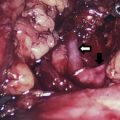Outpatient thyroid surgery is controversial because of concerns over life-threatening cervical hematoma. Despite this concern, outpatient thyroidectomy is becoming increasingly common, especially among high-volume endocrine surgeons. Multiple studies have now demonstrated that careful patient selection combined with surgeon experience can result in successful and safe surgery without a full inpatient admission. This article reviews the data on safety and outcomes for outpatient thyroidectomy and discusses several techniques used to minimize risk to patients.
Key points
- •
Safely performing outpatient thyroid surgery requires careful patient selection and preparation.
- •
It is important to identify both social and medical factors that place patients at higher risk for complications.
- •
Communication with patients is a key element of success because they must be able to identify postoperative complications and contact the surgical team.
- •
Choice of anesthetic agent and other medications can help to reduce postoperative nausea and vomiting to facilitate early discharge.
Background
Thyroidectomy has traditionally been considered an inpatient procedure owing to concerns over the potential life-threatening consequences of a postoperative cervical hematoma. However, recent years have seen an increase in the volume of outpatient thyroidectomy because high-volume thyroid surgeons are frequently discharging patients on the same day or the morning after surgery. Although outpatient thyroidectomy is becoming increasingly common, there remains considerable controversy over whether the best interests of patients are truly being served by anything less than a full inpatient admission after thyroid surgery. Advocates for outpatient thyroidectomy point to low complication rates, decreased costs, and improved patient satisfaction as justifications for avoiding admission in carefully selected patients. Opponents of outpatient thyroid surgery generally cite concerns over missed hematomas as well as difficulty managing hypocalcemia as reasons for keeping patients in the hospital long enough to ensure that discharge is safe. Additionally, it is not entirely clear how to identify patients who can undergo outpatient thyroidectomy safely versus those who would benefit from additional supervision in the inpatient setting.
The American Thyroid Association (ATA) recently attempted to address the controversy over outpatient thyroidectomy by issuing a position paper that reviewed the evidence demonstrating safety and attempted to establish criteria for proper patient selection. The final recommendation is that “outpatient thyroidectomy may be undertaken safely in a carefully selected patient population provided that certain precautionary measures are taken.” The present article expands on the ATA recommendations and attempts to offer practical advice for surgeons who wish to begin an outpatient thyroidectomy practice.
Background
Thyroidectomy has traditionally been considered an inpatient procedure owing to concerns over the potential life-threatening consequences of a postoperative cervical hematoma. However, recent years have seen an increase in the volume of outpatient thyroidectomy because high-volume thyroid surgeons are frequently discharging patients on the same day or the morning after surgery. Although outpatient thyroidectomy is becoming increasingly common, there remains considerable controversy over whether the best interests of patients are truly being served by anything less than a full inpatient admission after thyroid surgery. Advocates for outpatient thyroidectomy point to low complication rates, decreased costs, and improved patient satisfaction as justifications for avoiding admission in carefully selected patients. Opponents of outpatient thyroid surgery generally cite concerns over missed hematomas as well as difficulty managing hypocalcemia as reasons for keeping patients in the hospital long enough to ensure that discharge is safe. Additionally, it is not entirely clear how to identify patients who can undergo outpatient thyroidectomy safely versus those who would benefit from additional supervision in the inpatient setting.
The American Thyroid Association (ATA) recently attempted to address the controversy over outpatient thyroidectomy by issuing a position paper that reviewed the evidence demonstrating safety and attempted to establish criteria for proper patient selection. The final recommendation is that “outpatient thyroidectomy may be undertaken safely in a carefully selected patient population provided that certain precautionary measures are taken.” The present article expands on the ATA recommendations and attempts to offer practical advice for surgeons who wish to begin an outpatient thyroidectomy practice.
Definition of outpatient thyroidectomy
One issue that has complicated analysis of outcomes for outpatient thyroidectomy is that the actual definition of “outpatient” surgery has been somewhat variable. Some groups categorize a thyroidectomy as an outpatient procedure only if performed at an ambulatory surgery center with discharge occurring the same day as surgery. Others classify a patient admitted for a 23-hour observation period as an outpatient because the hospital does not categorize this as a full admission. When analyzing national trends in outpatient thyroidectomy, it is important to remember that many datasets lack the ability to distinguish between these 2 definitions of outpatient surgery. A certain degree of caution is required when interpreting studies using datasets that merge same-day surgery and 23-hour observation. For the sake of completeness, we discuss data from papers using either definition, but we note ( Table 1 ) which approach was taken in the individual studies.
| Author | Total n | Hematoma (%) | Timing of Hematoma (Range) | Predictors | Mortality (%) | Exclusion for Outpatient |
|---|---|---|---|---|---|---|
| Bergamaschi et al, 1998 | 1163 | 1.6 | 15 min–15 d | NR | 0.08 | NR |
| Bergenfelz et al, 2008 | 3660 | 2.1 | NR | Age, male | 0 | NR |
| Bononi et al, 2010 | 562 | 0.53 | <24 h–4 d | NR | 0 | NR |
| Burkey et al, 2001 | 13,817 | 0.3 | 10 min–5 d | None found | 0 | NR |
| Champault et al, 2009 | 95 | 1 | 2 h | NR | 0 | ASA ≥3, anticoagulation, OSA, >75 years old, >50 km from hospital, no phone, no one to stay with patient, toxic adenoma, indeterminate FNA, completion surgery |
| Chang et al, 2011 | 1935 | 0.98 | NR | NR | 0.05 | NR |
| Godballe et al, 2009 | 5490 | 4.2 | 0–5 d | Age 50, male, drain, malignancy, consultant as surgeon, bilateral procedure | 0 | NR |
| Hessman, 2011 | 148 | 1.3 | 3 and 5 d | NR | 0 | None |
| Inabnet et al, 2008 | 224 | 1 | 1 h | NR | 0 | NR |
| Lang et al, 2012 | 3086 | 0.7 | <6–24 h | Reoperation, nodule size, male | 0 | NR |
| Leyre et al, 2008 | 6830 | 1 | <6–>24 h | Male, preoperative dyspnea | 0 | NR |
| Mazeh et al, 2012 | 608 | 1 | 3–<24 h | NR | 0 | Patient preference, comorbidity needing monitoring, lymph node dissection, reoperation |
| Mowschenson et al, 1995 | 100 | 0 | NR | NR | 0 | None |
| Promberger et al, 2012 | 30,142 | 1.7 | <1–>24 h | Age, male, bilateral, extent of resection, reoperation | 0.01 | NR |
| Rosato et al, 2004 | 14,934 | 1.2 | NR | NR | 0 | NR |
| Rosenbaum et al, 2008 | 1050 | 0.6 | <4 h–7 d | NR | 0 | NR |
| Samson et al, 1997 | 1178 | 0 | NR | NR | 0.08 | Elderly, comorbidity |
| Seybt et al, 2010 | 418: 208 OP, 201 IP | 0.24 | 20 d | NR | 0 | Comorbidity, anticoagulation or need for drain, concomitant procedures, lack of autonomy or social support |
| Snyder et al, 2006 | 58 | 3.4 | 30 min–5 d | NR | 0 | NR |
| Snyder et al, 2006 | 1242 | 0.4 | 2 h–2 d | NR | 0.3 | Lymph node dissection, sternotomy, other procedures normally on inpatient basis |
| Spanknebel et al, 2005 | 1025 | 0.5 | <6 h | NR | 0 | Anticoagulation, language barrier/cannot communicate, live in remote regions, living alone, difficult/extensive procedure, preference |
| Stack et al, 2013 | 38,362 | 0.03 | NR | NR | 0 | NR |
| Terris et al, 2007 | 91: 52 OP, 26 observation, 13 IP | 1.1 | 8 d | NR | 0 | Comorbidity, concomitant procedure, preference, drains |
| Thomusch et al, 2000 | 7266 | 2.7 | NR | NR | 0.04 | NR |
| Trottier et al, 2009 | 232 | 0.4 | 2 d | NR | 0 | Lives in city or will stay within 1 h, adult around ×48 h, or done by 1 pm , total thyroidectomy as first procedure of the day only |
| Rios-Zambudio et al, 2004 | 301 | 0.97 | NR | NR | 0 | NR |
Benefits of outpatient thyroidectomy
Cost
One of the main considerations prompting surgeons to perform outpatient thyroidectomy is the potential cost savings of avoiding a full inpatient admission. Mowschenson and colleagues showed a $900 reduction in charges for outpatient versus inpatient thyroid surgery, whereas Terris and colleagues showed charges of $10,288 for inpatient compared with $7814 for outpatient thyroidectomy. Although the 2 studies involve analysis of charges rather than actual costs, it does seem reasonable that fewer hospital resources are needed to care for a shorter rather than a longer stay. Because both studies defined outpatient surgery as a same-day discharge, it is less clear whether a 23-hour observation leads to substantially lower cost for the hospital or the patient. Stack and colleagues evaluated both mean and median charges for a full inpatient admission compared with any stay less than 24 hours and found no difference in median charges, although analysis of mean charges did favor the outpatient approach.
Patient Satisfaction
Another argument for the value of outpatient thyroidectomy is that patients will be happier if they are able to avoid admission and can recover in the comfort of their own home. Although the notion that most individuals would rather be at home than in the hospital has considerable face validity, the supporting evidence is somewhat limited. Mowschenson and colleagues surveyed patients undergoing outpatient thyroidectomy and found that 65% were satisfied with their care. As a control, they also surveyed patients undergoing laparoscopic cholecystectomy and found that 68% were satisfied. The authors concluded that outpatient thyroid surgery was just as acceptable to patients as other outpatient surgeries. Samson and colleagues conducted a randomized trial of inpatient versus outpatient thyroid surgery in the Philippines as well as a separate analysis of patients treated after the trial. They found that 798 of 809 outpatients (99%) were “very pleased” with their care compared with only 25 of 369 (7%) in the inpatient group. Although it seems that the majority of patients who undergo outpatient thyroidectomy are reasonably satisfied with the experience, it is important to remember that a subset of patients are uncomfortable with the idea of going home right after having surgery. These individuals may gain more reassurance and ultimately be more satisfied with their perioperative experience by a full admission, even in the absence of any complications.
Other Benefits
In addition to cost savings and patient satisfaction, some have advocated for outpatient thyroidectomy as a way to minimize potential iatrogenic complications, including exposure to multidrug-resistant organisms and other nosocomial infections. It does seem reasonable that shorter hospital stays result in less time exposed to hospital-based organisms, but the value of shortening that exposure time from 24 to 6 hours is not entirely clear. Other potential iatrogenic injuries include venous thrombosis or infection from maintaining peripheral intravenous lines as well as allergic reactions or other complications from medications administered in the hospital. Again, there is little evidence to quantify the benefits of outpatient over inpatient surgery with regard to avoiding iatrogenic complications, but it at least represents a theoretic benefit.
Stay updated, free articles. Join our Telegram channel

Full access? Get Clinical Tree





